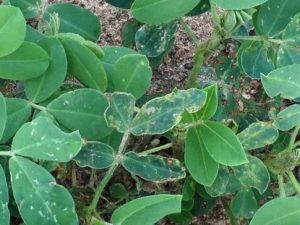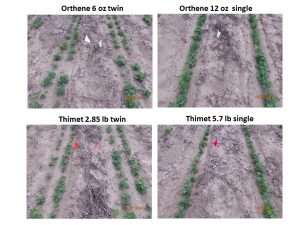One of the earliest insect pests of peanuts includes the small flying insects called thrips. Thrips have bristly wings and can fly or ride the air currents over long distances. There are several species of thrips that can be found on peanuts, most commonly the tobacco thrips and the western flower thrips. Thrips also transmit the spotted wilt disease in peanuts caused by virus.

Peanut plant with thrips damage.
Thrips adults are good at finding host plants as they migrate to peanut fields and start feeding on the terminal leaves of peanut seedlings with their rasping mouthparts. This extensive feeding can cause severe leaf deformation and death of small plants that may be exacerbated by drought or unfavorable growing conditions for peanuts. Adults also lay eggs on peanut stem terminals that hatch into small yellow immature thrips that start a fresh generation (2-3 week life cycle). Thrips are capable of reproducing parthenogenetically, so populations can increase rapidly over few weeks and overcome the seedlings.
Many peanut producers use phorate (Thimet) as in-furrow treatment and that protects plants when adequate levels of soil moisture is present. Other in-furrow products we have tested and found effective at labelled rates in single-row planting system include imidacloprid (Admire Pro 4.6F and Velum Total pre-mix) and acephate (Orthene, can also be applied foliar).
A word of caution – if you are applying to peanuts as twin rows then you are splitting application over two rows that definitively reduces the effectiveness of in-furrow insecticides. You will need to watch out for high thrips populations this summer and apply rescue foliar insecticides for thrips control as needed.
Some excellent foliar materials include spinetoram (Radiant 1 SC), novaluron (Diamond 0.83EC), and others. Radiant is an excellent rescue insecticide against thrips that is also effective against small caterpillars and other pests that may visit peanut plants.

Twin vs single row thrips
Consult the Peanut IPM Guide (link below) for finding all insecticide choices and follow the label. Plan your IPM strategy to include insecticides from different chemical classes to avoid insecticide resistance. Consult a regional extension agent if you need assistance with insect identification and IPM planning suitable for your location.
Subscribe to the Alabama IPM Communicator E-newsletter for future pest
alerts, visit www.aces.edu/ipmcommunicator and click the subscription button. Insect monitoring and reporting program is funded by grants from the Alabama Peanut Producers Association and the National Peanut Board.
Further reading: Peanut IPM Guide (IPM-60):
https://www.aces.edu/blog/topics/crop-production/peanut-ipm-guide/
Timely information from Dr. Ayanava Majumdar (Extension Professor), Kris Balkcom (Extension Specialist) and Dr. Scott Graham (Assistant Professor/Extension Specialist) from Auburn University.
